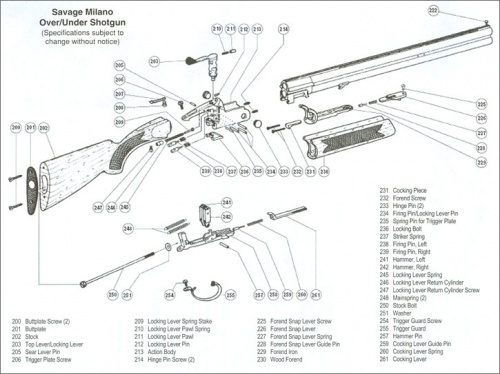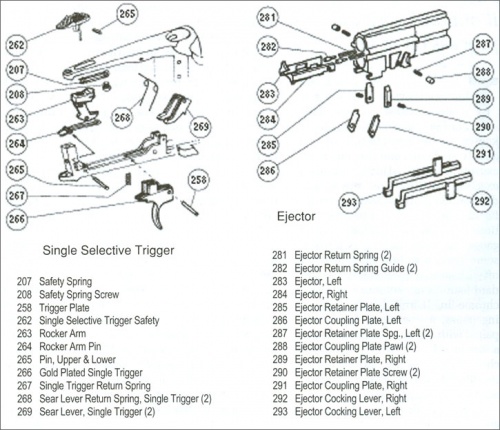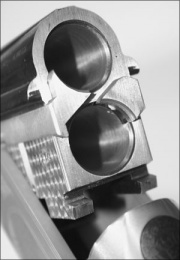How to disassemble a Savage Milano
The Savage Milano over/under is made in Brescia[1], Italy, which has a reputation for making quality shotguns, and this one is no exception. The result is a shotgun with a weight distribution that is nearly perfect for most shooters. Its 12-, 20-, 28-gauge, and .410 actions are precisely scaled to their gauge, and standard features include automatic ejectors, chrome-lined barrels, lengthened forcing cones, a fiber-optic front sight paired with a brass, mid-rib bead, and a single selective trigger and, of course, screw-in chokes (except for the .410 — its 28" barrels come in fixed, modified, or improved cylinder, and you're stuck with whatever one you buy).
| Hey, here's a bright idea: There’s only one right way to take a gun apart: the way the factory does it. That’s a good rule. Sticking to it can save manufacturers and their service people a lot of time by not having to figure out just what the hell might (or might not) be wrong with a firearm that was yanked apart by its owner, dropped in a plastic bag, and handed off to some innocent gunsmith ("what did I ever do to you?") to put back together again. |
- Think first
- In detail stripping the shotgun, make a slave pin to substitute for every pin you remove. You’ll need them to keep parts in place during reassembly, and many of those parts will have been under pressure exerted by one spring or another (SPROING! Goddamn it, where'd it go??).
- Equally important: Keep track of which firing pin, sear lever, and so forth is taken from the top side of the action, which is from the bottom, and which is from the right or left side of anything. DO NOT get them mixed up - this can cause brain damage, halitosis, alcoholism and thinking like a liberal.
[edit] Basic field stripping
The shotgun is unloaded, the trigger has been pulled to lower the hammers, the safety is on, and you’re wearing safety glasses. Right? In the center of the underside of the forearm is a release lever located in an oval depression in the wood. Pull the lever toward the rear of the gun. At the same time (or close to it) pull the front end of the forend away from the barrels. Move the top lever to the right, open the action, and lift the barrels free.
[edit] Detailed disassembly
The manual safety of the Milano disconnects the rocker arm from the sear levers and the safety switch on the tang has a dual function. There’s a movable button in its center. When the button is moved to the right, a single black dot is shown and the bottom barrel will fire first. When moved to the left, two black dots are shown and the top barrel fires first. The ejectors are controlled by the hammer position and cocking levers, and will only fully eject hulls that have been fired. Unfired rounds are partially extracted and easily taken out by hand.
- You're going to need
- a 7/16" socket
- a long extension for the socket wrench
- a #2 Phillips screwdriver
- a large plastic bag.
- Now you...
- Remove the recoil pad screws (#200) after dipping the #2 Phillips into a jar of Vaseline. Separate the recoil pad (#201) from the stock (#202).
- Check the socket in the stock-bolt hole for clearance between the socket and the wood. If it’s a tight fit, grind down the outside of the socket until there’s enough room in there to get hold of the stock bolt (#250) without taking a chance of cracking the wood.
- Back out the bolt along with the stock washer (#251). Now pull the stock to the rear to disengage it from the frame.
- The hammers should still be in the fired position. Remove the upper pin (#265) that retains the safety assembly, and remove the assembly from the upper tang.
- You’ve just exposed a screw (#206). Remove it and the trigger-plate pin (#235), and then tilt the rear of the trigger plate (#258) away from the frame.
- The mainspring assemblies (#248) can be removed by rotating the hammers forward and releasing the mainspring plungers from their seats in the rear of the hammers. They are removed from the frame to the rear. Don’t disassemble them further. When replacing, insert the rear of the assembly into its frame hole, move the sear lever up and the hammer as far forward as possible, and then pry the front end of the plunger onto the back of the hammer and into its hammer seat.
- Note: An unlikely circumstance could arise (a broken plunger spring) where just the mainspring assembly needs to be removed. This can be done without taking off the lower tang. With the hammer rotated forward, use a small tool to lever the plunger out of the hammer, and then move it upward and forward to separate it from the frame.
- Now for the lower tang. Remove the trigger guard screw (#254) from the top to free the rear of the guard. The rocker arm (#263) pivots on a ball at its bottom that rides in a matching cup on top of the trigger. It’s held in position by the rocker-arm spring (#264). Being careful not to damage the spring, you can remove the rocker arm by rotating it forward and sliding it between the spring’s arms. Unless the spring must be replaced, you probably shouldn't remove it; it’s under tension as assembled. If replacement is required, however, position the spring against the tension provided when its tails are placed against the frame, and secure it there with its pin.
- Turn the trigger guard to the side. Remove the trigger (#266) and spring (#267) by drifting out the pin numbered 258 on the selective trigger schematic. There's no number for this pin and #258 on the main schematic parts list is the lower tang. Note that there are two pivot-pin holes in the trigger plate to accommodate differing trigger mechanisms. The single selective trigger in this Milano uses the front hole.
- Unscrew the guard by rotating it out clockwise.
- Remove the left hammer (#241) and the right hammer (#242) by drifting out their pin (#257). Keep this in mind: The left hammer must be reinstalled in the trigger plate from whence it came. So must the right hammer. Otherwise, neither will fit or function.
Although the firing pins can be removed and replaced while the trigger plate is in place, normally they aren't. Start by drifting out both pins (#234). This frees the firing pins (#238 and 239) plus their springs (#237). The firing pins are NOT the same - they differ slightly one from the other. Mix them up? Not! They go back in the same hole from which you took them.
- After the firing pins and springs are removed, place the frame in a large plastic bag before going after the locking lever (#203). You’re about to encounter parts that are under spring tension, and just waiting for the chance to fly off to God-only-knows-where. Good luck finding them. Bring the kids and make a day of it...
- So, once you've got the frame in your handy-dandy bag, back out the locking-lever return cylinder screw (#247). This releases the locking lever cylinder (#246), lever spring (#245) and spring stake (#206) into the bag.
Replacing these parts is an absolute bugger of a job, even for factory gunsmiths. Like the guys at Savage, you’ll have to figure out a way of getting them back together that works for you. Do some advanced planning as you take the gun down - it'll totally pay off.
- After removing the locking-lever pin (#234) and trigger-plate pin (#235), pay attention to how the slot in #234, a roll pin, orients to the bottom. It must be in the same position when reinstalled to retain freedom of movement for the locking lever.
- Now push the locking-lever pawl (#211) flush with the front of the lever and clear of the frame.
- Lift and turn the lever while retaining the pawl and its spring in the lever to disengage the locking bolt (#236).
- Remove the locking bolt to the rear.
The ejector cocking levers (#292 & 293) slide rearward and out of the frame through the opening for the trigger plate. Before going after the sear levers (#269) and sear-lever springs (#268), study how the springs are positioned under tension. Plan ahead. They have to be in the same position for reassembly; a slave pin will be the thing that holds them there.
The forend iron (#229) is attached to the forend by two more Phillips-head screws (#232). The forend-snap lever (#226) is attached to the forend by its screw (#225). The head of this screw is in a clearance on the top of the iron to allow lateral movement. The snap lever itself retains its spring (#227) and guide pin (#228). BEWARE OF A FLYING SPRING when you remove the lever. At the rear of the iron is the cocking piece (#231). It’s been driven into a dovetail slot and staked there. Unless it is damaged, leave it alone. Seriously; don't muck with it.
This is a good time for a little more detail on the barrel assembly. The tubes are fitted in a monoblock and have a vented top rib. The light-gathering front sight is screwed into that rib. The mid-site is driven in, and a strong adhesive used to secure it in place. When you take this section apart, remember the “which is right and which is left” rule. The ejector/extraction system is housed inside the monoblock, but it's activated by the frame and cocking levers. The left ejector (#283) and right ejector (#284) are retained in the block by a left retainer plate (#285) and ejector plate right (#289), both of which are secured by ejector plate screws (#290).
The way the factory puts them together, the ejectors are under pressure from the ejector springs (#281) and their guides (#282). Their function as an extractor or as an ejector is determined by the ejector coupling plates (#286 and #291). These are set to catch the ejector when a barrel is fired by the ejector cocking levers. A cocking lever matching the fired barrel is moved forward by that barrel’s hammer to raise that ejector’s coupling plate. This holds the ejector in place as the action is opened. The ejector so held will remain held until the barrels are almost clear of the breechface. Then a surface on the frame cams the retaining plate out of engagement with the ejector and out pops a spent shell. None of this happens with a barrel containing a live or dud round. In that case, the coupling plate of the barrel’s ejector is held in the lower position, allowing the ejector to move back under spring pressure and serve as an extractor.
And that, boys and girls, is how the ejector/extractor system of the Milano’s single selective trigger works.
But wait a minute, there’s more. To remove the ejectors, press them into the monoblock to catch them by the coupling plate. Unscrew part #290 until the plate can be lowered in its dovetail slot. Remember that an ejector is under spring pressure as you release it from the block. Once it’s out, remove the ejector-guide pin and spring.
As is often said — and is true in this case — reassemble everything in the reverse order. And don’t forget to use those slave pins and that plastic bag. Otherwise, plan to waste an hour or more looking ... everygoddamwhere.
[edit] Notes
- ↑ Brescia was handling all the production. Sure, they were following Savage specs, but no one from Savage Arms was on the scene looking over the shoulders of the technicians who assembled the Milano for final shipment.
- ↑ Some shooters, especially those who kill hundreds of clay birds, feel that mechanical resetting is better than recoil because with recoil, the second barrel won’t fire if the first barrel fails to. The mechanical reset in the Milano eliminates this kind of frustration.



